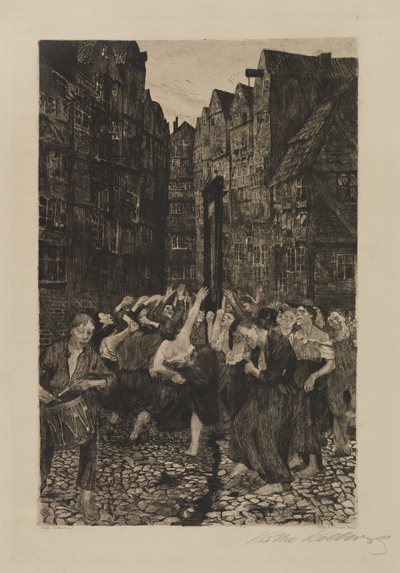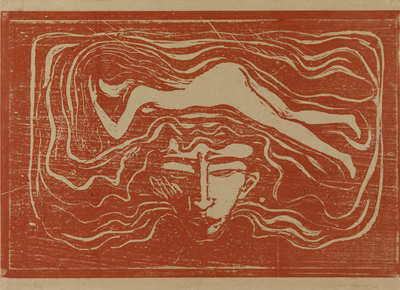The German Revolution at The Hunterian Art Gallery
 The German Revolution: Expressionist Prints
The German Revolution: Expressionist Prints
1 March - 25 August 2019
Hunterian Art Gallery
Admission free
A new exhibition opening at the Hunterian Art Gallery this March will offer a rare opportunity to see key works from The Hunterian’s pioneering collection of German Expressionist prints.
The major exhibition, The German Revolution: Expressionist Prints, focuses on the revolutionary printmaking that emerged in Germany in the years 1906-1926 and explores artists’ responses to the social and political forces driving the German Revolution of 1918-1919.
The German Revolution presents works by a range of stellar artists including Munch, Nolde, Schiele, Kokoschka, Beckmann, Kollwitz, Picasso, Goya, Gauguin, Modersohn-Becker, Münter and Motesiczky.
The German Revolution or November Revolution was a period of anarchy and violence that broke out at the end of the First World War, in Berlin and other big cities. Chaos continued until the establishment of the Weimar Republic in August 1919.
The exhibition and accompanying publication are timed to commemorate this turbulent period in Germany’s history and link the strong German tradition of graphic art with the social and political, sexual and moral struggles taking place at the time.
The German Revolution features 75 compelling works displayed thematically in sections titled Love and Anxiety, A Bridge to Utopia, and Conflict and Despair. The majority are drawn from The Hunterian’s own exceptional holdings of German Expressionist art, supplemented by loans from private collections and Max Beckmann’s set of 11 lithographs, Hell, on loan from the National Galleries of Scotland. (Please note that Hell is only on display until 9 June 2019).
This monumental series encapsulates the terror, hunger and sheer misery that enveloped the city of Berlin, which had been the German World’s great international centre for the production and exhibition of art.
 Artists such as Beckmann turned to printmaking of various kinds from commercial necessity. This was the great period of the woodcut, led by the Norwegian Edvard Munch, who inspired many to take up a medium which has dramatic persuasive power. Works by Munch, Picasso, Gauguin and Goya are also included to demonstrate the influence of other European artists on those working in Germany at the time.
Artists such as Beckmann turned to printmaking of various kinds from commercial necessity. This was the great period of the woodcut, led by the Norwegian Edvard Munch, who inspired many to take up a medium which has dramatic persuasive power. Works by Munch, Picasso, Gauguin and Goya are also included to demonstrate the influence of other European artists on those working in Germany at the time.
Other artists turned their backs on the physical destruction and looked inwards. Munch, Kokoschka, Schiele, Schmidt-Rottluff, Nolde, Pechstein, Heckel, Barlach, Dix, Grosz, Corinth and Modersohn-Becker all made prints exploring human stories which are linked thematically in the exhibition and seem to have arisen as an antidote to the disaster of the war.
Must see items include two works by Käthe Kollwitz, Die Carmagnole of 1901 and Three Studies of a Woman in Mourning, 1905; In the Man’s Brain, by Edvard Munch (1897); Fraülein Engelhardt by Marie-Louise von Motesiczky (1926-27); Max Beckmann’s Adam and Eve of 1917 and Pablo Picasso’s The Frugal Meal of 1904.
A number of the works featured in the exhibition, including Emil Nolde’s Scribes (1911) and Karl Schmidt-Rottluff’s Mourning Women on the Beach (1914), were purchased with the support of Art Fund and the National Fund for Acquisitions.
The German Revolution: Expressionist Prints is at the Hunterian Art Gallery from 1 March – 25 August 2019. Admission is free.
Hunterian Art Gallery
University of Glasgow
82 Hillhead Street
Glasgow G12 8QQ
Open Tuesday – Saturday 10.00am – 5.00pm and Sunday 11.00am – 4.00pm
Admission free
glasgow.ac.uk/hunterian
Images: Käthe Kollwitz, Die Carmagnole, 1901 © The Hunterian, University of Glasgow. Edvard Munch, In the Man’s Brain, 1897 © The Hunterian, University of Glasgow.
Further Information
For further information contact:
Dr Peter Black, Curator of Prints (General) and Italian, Dutch and German Old Masters, The Hunterian
For images contact:
Harriet Gaston, Communications Manager, The Hunterian
Notes for Editors
German Expressionist Prints at The Hunterian
The Hunterian is home to one of the UK’s most important collections of German Expressionist prints. The collection includes more the 100 works from the period 1880-1930 and there are major works, such as Egon Schiele’s Sorrow, that are unique to The Hunterian and not present in any other UK public collection.
In recent years, Hunterian curators have been steadily developing this collection that was begun, with considerable foresight, in the 1950s. The collection is impressive among museums in the UK where, as a consequence of two world wars, there was, for a long time, strong resistance to acquiring German works of art.
A number of the works featured in the exhibition were purchased with the support of Art Fund and National Fund for Acquisitions:
Art Fund
Emil Nolde, Scribes, 1911, etching
Max Beckmann, Adam and Eve, 1917, drypoint
National Fund for Acquisitions
Karl Schmidt-Rottluff, Mourning Women on the Beach, 1914, woodcut
Adolph Menzel, The large Death’s-head Hussar, 1846, etching
Käthe Kollwitz, La Carmagnole, 1901, etching
Kasimir Edschmid and Max Beckmann, The Duchess, book with drypoint illustrations
Art Fund and National Fund for Acquisitions
Käthe Kollwitz, Three Studies of a Woman in Mourning, 1905, charcoal drawing
Käthe Kollwitz, Woman with a Child on Her Arm, 1909, charcoal drawing
Marie-Louise von Motesiczky, Fraülein Engelhardt, 1926 - 1927, oil on canvas
The Hunterian
The Hunterian is one of the world's leading University museums and one of Scotland’s greatest cultural assets. Built on Dr William Hunter’s founding bequest, The Hunterian collections include scientific instruments used by James Watt, Joseph Lister and Lord Kelvin; outstanding Roman artefacts from the Antonine Wall; major natural and life sciences holdings; Hunter’s own extensive anatomical teaching collection; one of the world’s greatest numismatic collections and impressive ethnographic objects from Captain Cook’s Pacific voyages.
The Hunterian is also home to one of the most distinguished public art collections in Scotland and features the world’s largest permanent display of the work of James McNeill Whistler, the largest single holding of the work of Scottish artist, architect and designer Charles Rennie Mackintosh (1868–1928) and The Mackintosh House, the reassembled interiors from his Glasgow home.
glasgow.ac.uk/hunterian
National Fund for Acquisitions
The National Fund for Acquisitions, administered with Scottish Government funding by National Museums Scotland, contributes towards the acquisition of objects for the collections of museums, galleries, libraries and archives throughout Scotland. During financial year 2017/18, the NFA made 48 payments totalling £129,085 to 29 organisations, supporting acquisitions with a total purchase value of nearly £367,740.
Find out more about the work of the National Fund for Acquisitions on our webpage:
National Fund for Acquisitions
First published: 28 January 2019

